Top 13 Things to Do in Uyuni Bolivia and Surroundings
Visiting Uyuni was by far my most exciting and otherworldly experience in Bolivia and South America. This is one of the most remote areas in the world at an altitude of 3656 meters above sea level (11,995 feet). There are way more things to do in Uyuni than just visiting the largest salt flats in the world. I explored Uyuni and the surrounding area for 3 full days and 2 nights with a tour and felt that there were still things left to do or to see. This trip was one of the most physically demanding trips I had in my life because of the high altitude, remoteness, and cold nights, but it was absolutely worth it.
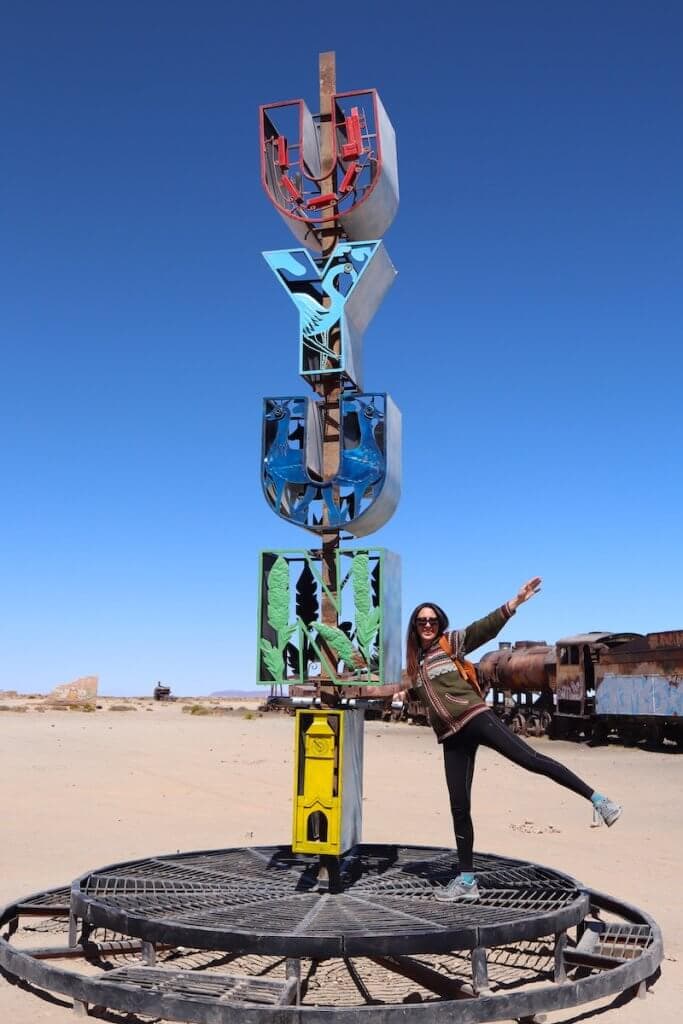
How to Get to Uyuni
Uyuni is located in a very remote area in southwest Bolivia. The closest city to Uyuni is Potosi. The trip from Potosí to Uyuni takes approximately 7 hours by bus.
Uyuni has a tiny airport served only by one local airline which offers regular flights from La Paz and Cochabamba.
The third option to get to Uyuni is taking a tour from Sanpedro de Atacama or Calama in Chile. The most popular tour is 3 days and 2 nights tour on 4×4 wheels.
How Many Days in Uyuni
Uyuni became a world-famous destination for tourism thanks to having the largest salt flats in the world (Salar de Uyuni). If you want to see only the famous salt flats of Uyuni, one full day will be enough, plus an overnight stay in Uyuni. But Uyuni has much more to offer than the salt flats. The nearby area is home to volcanos, geysers, colorful lakes full of flamingos, thermal baths, and pure wilderness which is very rare to see these days. To see the natural attractions of Uyuni and the nearby area, you would need to stay at least 3 full days.
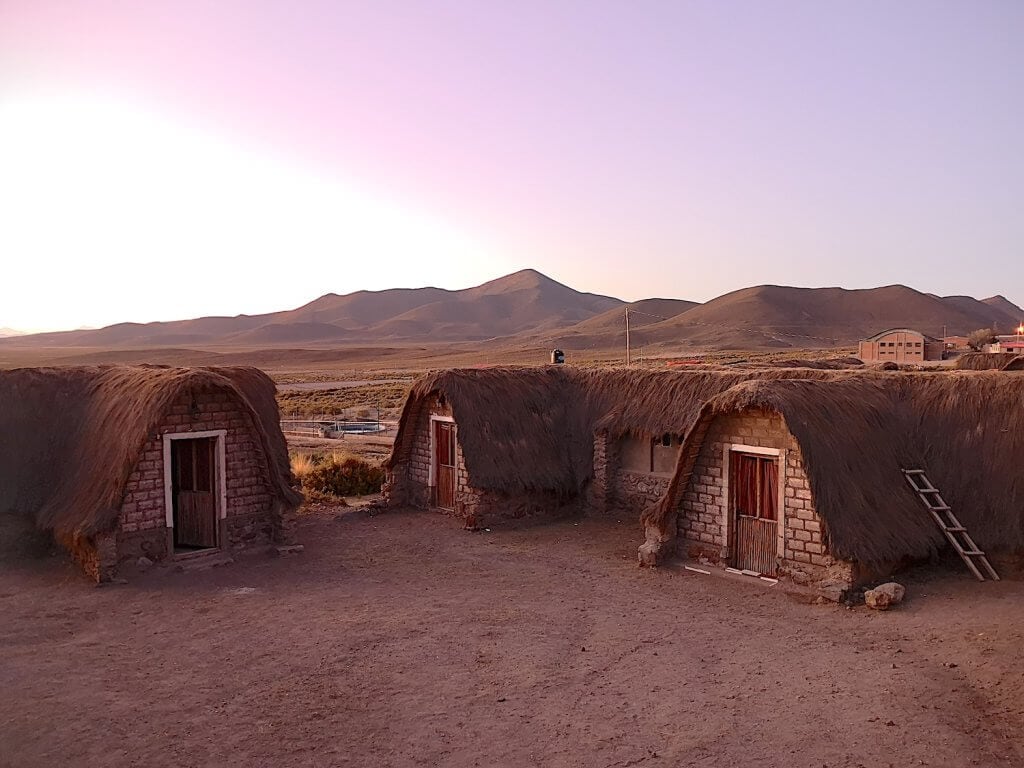
Don’t have time to read the entire article?
Check out this Classic 3-Day Uyuni Tour
with a perfect ⭐️⭐️⭐️⭐️⭐️ rating.
Best Things to Do in Uyuni
1. Visit Train Cemetery (Cemeterio de Trenes )
After staying the first night in the Uyuni town which doesn’t have much to offer, our first stop was the Train Cemetery. It is located in the outskirts of Uyuni bordering the salt flats. It’s home to old rotting trains dating back to the 19th century built by British engineers. You can find here over 100 trains of various sizes and shapes partially covered with graffiti. Uyuni was originally planned to be a central hub connecting different cities in Bolivia. Those trains were meant to carry minerals to major ports on the Pacific Ocean and were mostly used by mining companies. After the collapse of the mining industry in the 1940s those trains were abandoned forming the train cemetery. Nowadays it is a major tourist attraction in Uyuni and Bolivia.
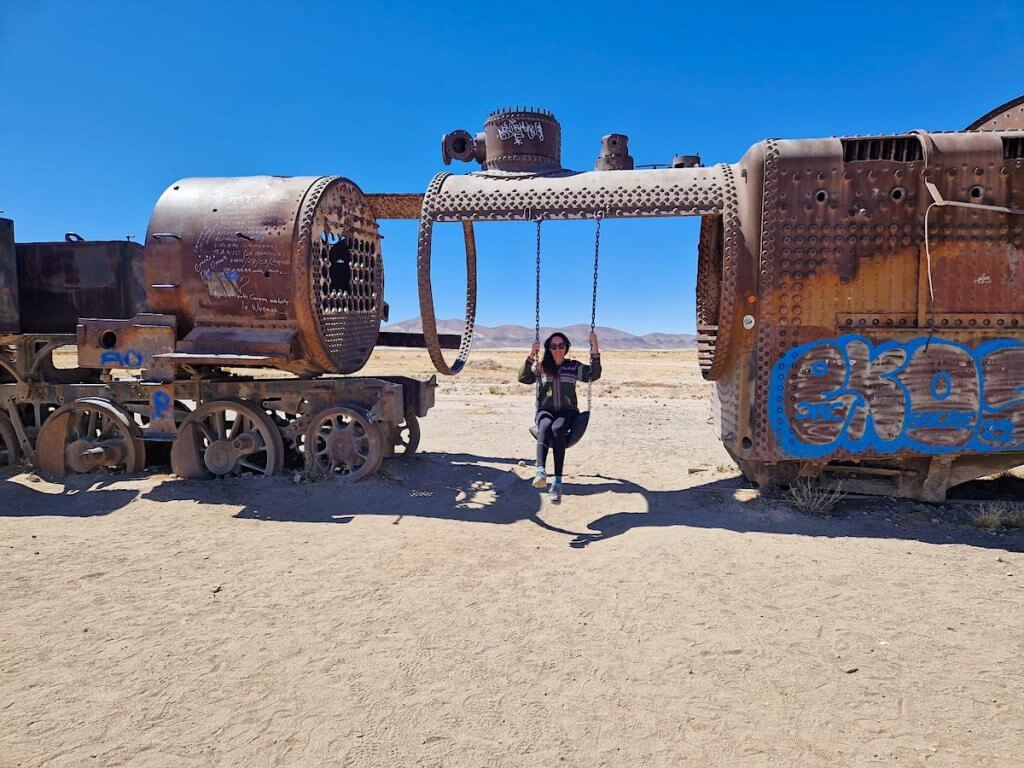
2. Visit an Old Salt Hotel and Hang your Country Flag
After visiting the old train graveyard and entering the white surface of salt flats, our second stop was the remains of an old hotel made entirely of salt, Palacio del Sal, and a nearby small square featuring a collection of flags from different countries ( Plaza de las Banderas). Those flags were brought there mainly by tourists. At that moment I regretted that I didn’t bring the flag of my country Armenia. But hey, maybe it is a sign that I should visit Uyuni and salt flats again someday in the future.
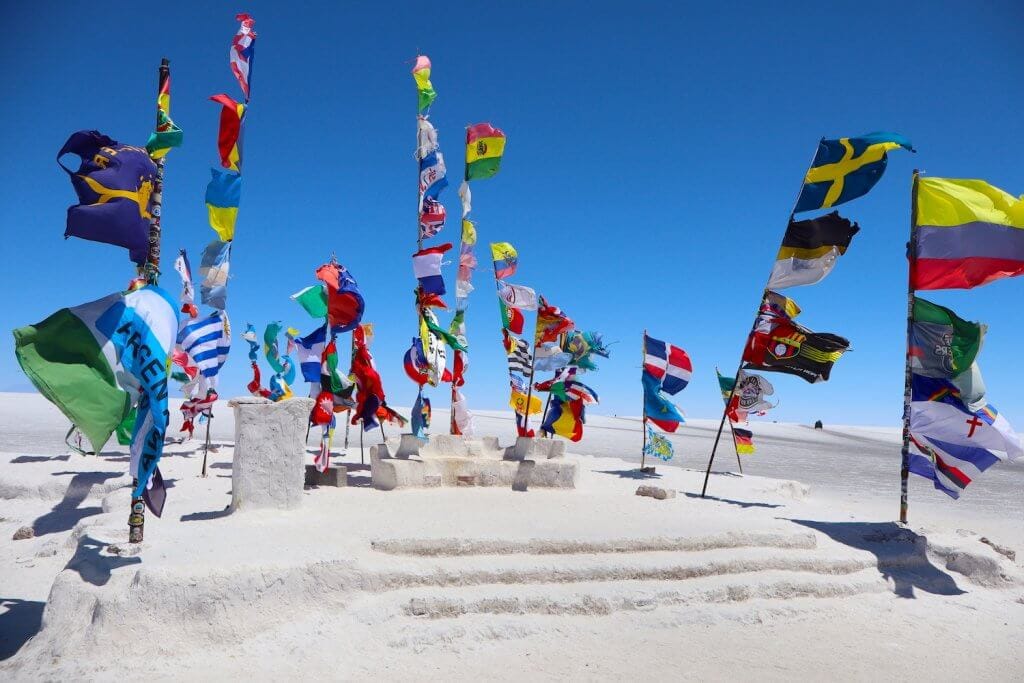
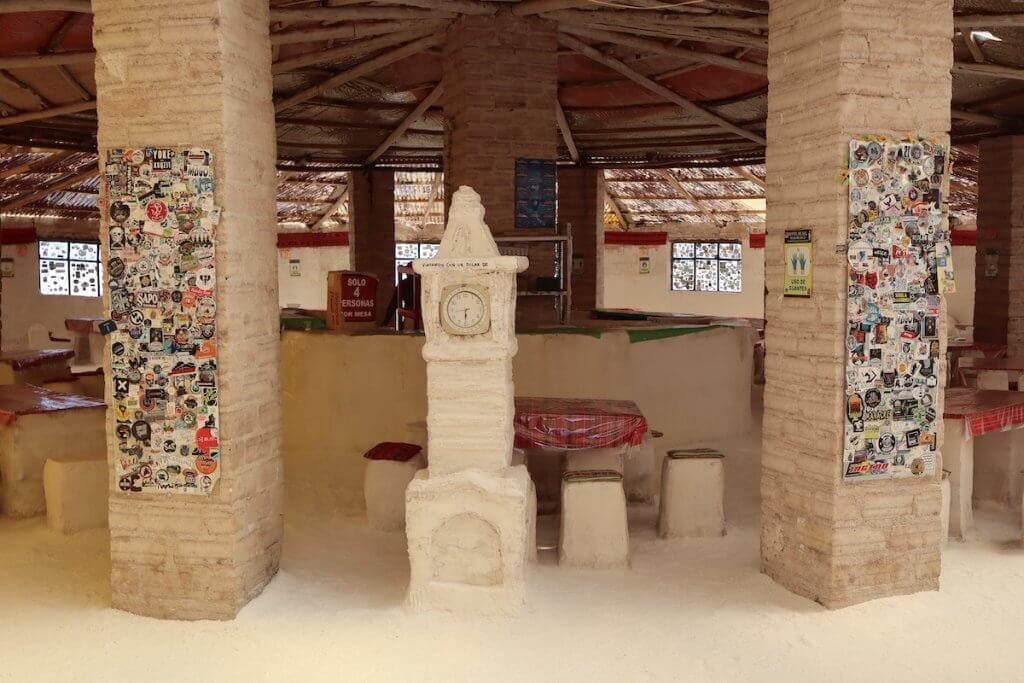
3. Check Out Dakar Monumet
After finishing our little photo session with the flags and visiting the old salt hotel, we moved towards our third stop, the Dakar Monument made entirely of salt of course. Since 2014 Bolivia together with neighboring Peru and Argentina has been included in the route of the famous Dakar rally. The contestants drive across South American off-road terrain on various motor vehicles.
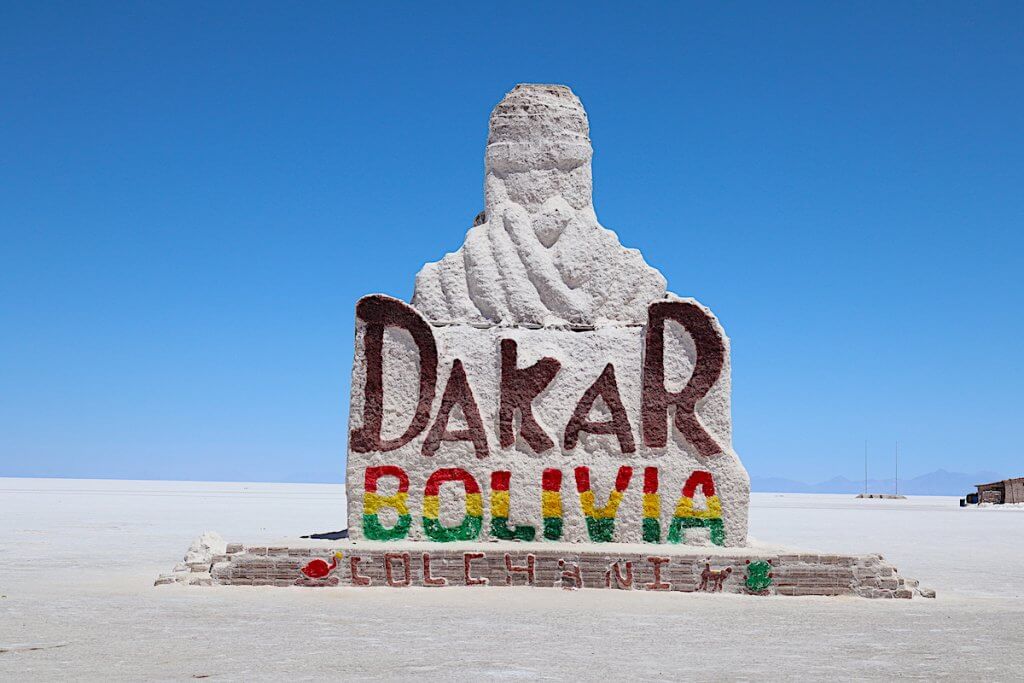
4. Get Creative on Salar de Uyuni (Salt Flats)
Uyuni salt flats, or Salar de Uyuni, at over 10,000 square kilometers (3,900 sq mi), are the largest salt flats in the world. During the rainy season, the flat becomes the world’s largest mirror. The salt flats of Uyuni were the main reason why I always wanted to visit Bolivia.
Most of the people who heard about Bolivia, did so thanks to the surreal-looking postcards from the salt flats. You can get all kinds of optical illusion and the mirror effect, thanks to the flat surface, hexagonal formations, clear sky, and endless white desert.
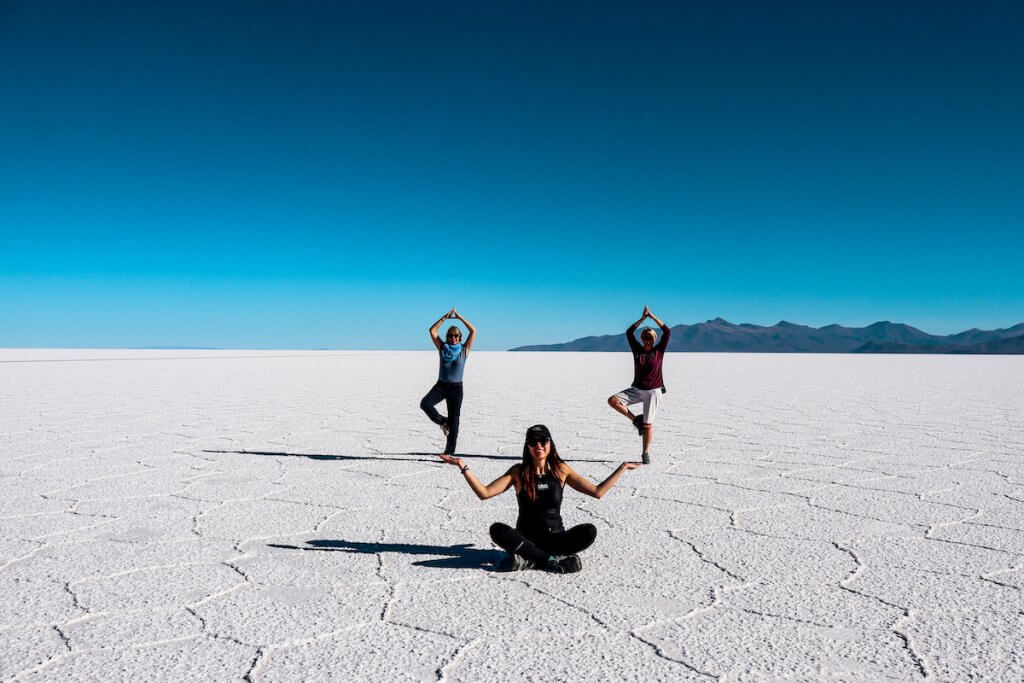
When we arrived in the middle of the flats to the most photographic location, we saw the Tunupa Volcano from the distance making the scenery even richer and more spectacular. The volcano looks tiny from the distance but in reality, it is a giant standing at 5321 meters above sea level overlooking the salt flats of Uyuni.
5. Look at the Eyes of the Salt Flat (Ojos de Sal)
I was surprised to find out that there are networks of subterranean rivers flowing under a very thick layer of salt on Salar de Uyuni. Locals believe that the water of those rivers has healing properties and is full of healing minerals. There is a place on the salt flat where bubbly springs get out to the surface forming the Eyes of the Salt Flat or Ojos de Sal, due to its shape.
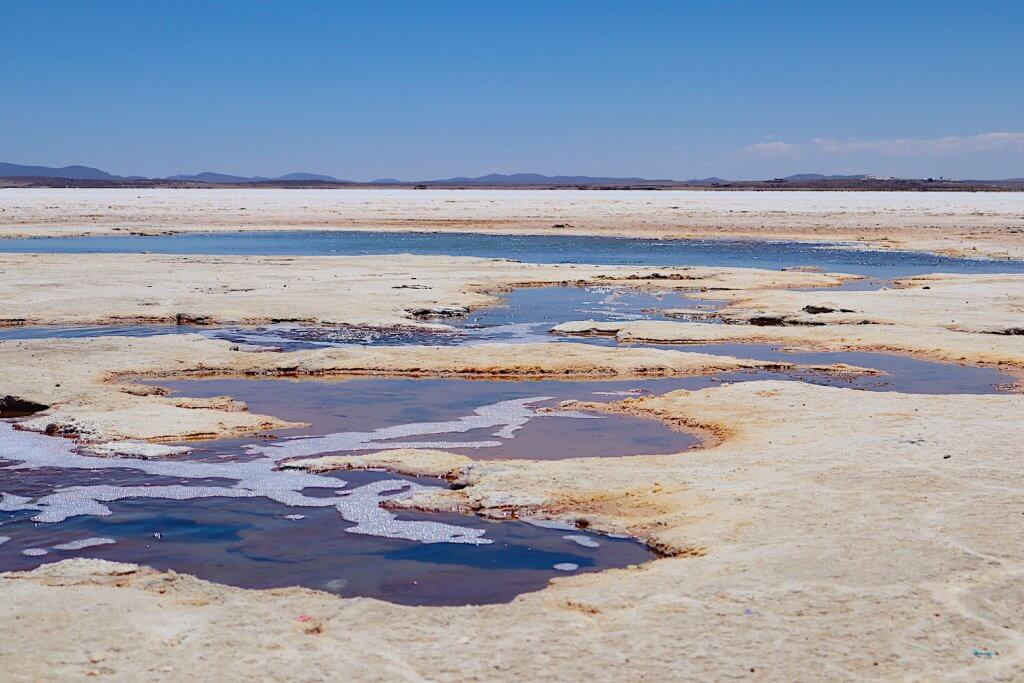
6. Climb up the Incahuasi Island
Incahuasi Island also known as the cactus island thanks to giant cactuses covering the entire surface of the island, is one of the two main islands in the middle of Salar de Uyuni. Here we finally found some form of modest infrastructure, had a chance to use a clean bathroom for 5 Bolivianos, and had a picnic on tables made entirely of salt.
After resting a bit and having our lunch, we decided to climb to the top of the island for the best views. The climb itself was not that hard, but due to my headache, I didn’t manage to reach the top. Nevertheless, I managed to enjoy great views over the salt flat and surrounding volcanos.
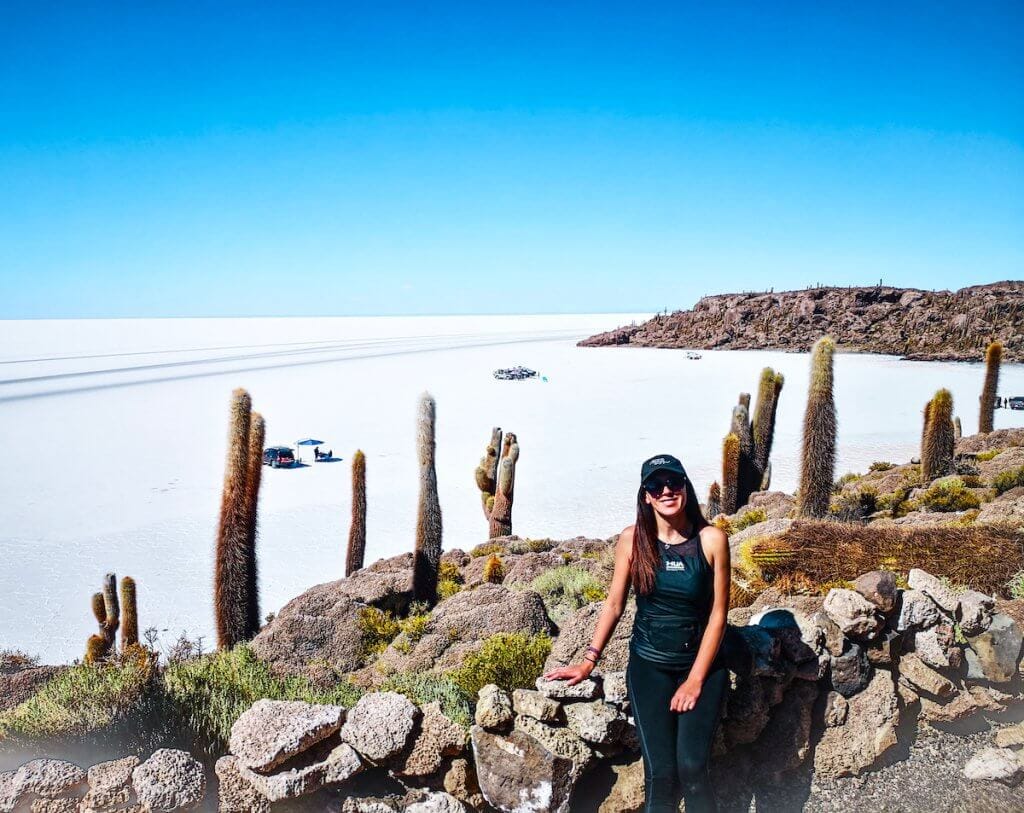
7. Admire the Impresive Ollagüe Volcano
Ollagüe or Ullawi is a massive volcano in the Andes on the border between Chile and Argentina. It is rising proudly at 5,868 meters (19,252 ft) above sea level. If you want to climb the volcano you would need to go on the Chilean side and be very fit and well-equipped because the hike is pretty demanding. But the good news is that there is a great viewpoint on the Bolivian side where you can admire this impressive giant at your own convenience. If you are lucky you might see the smoke coming of the crater of the volcano.
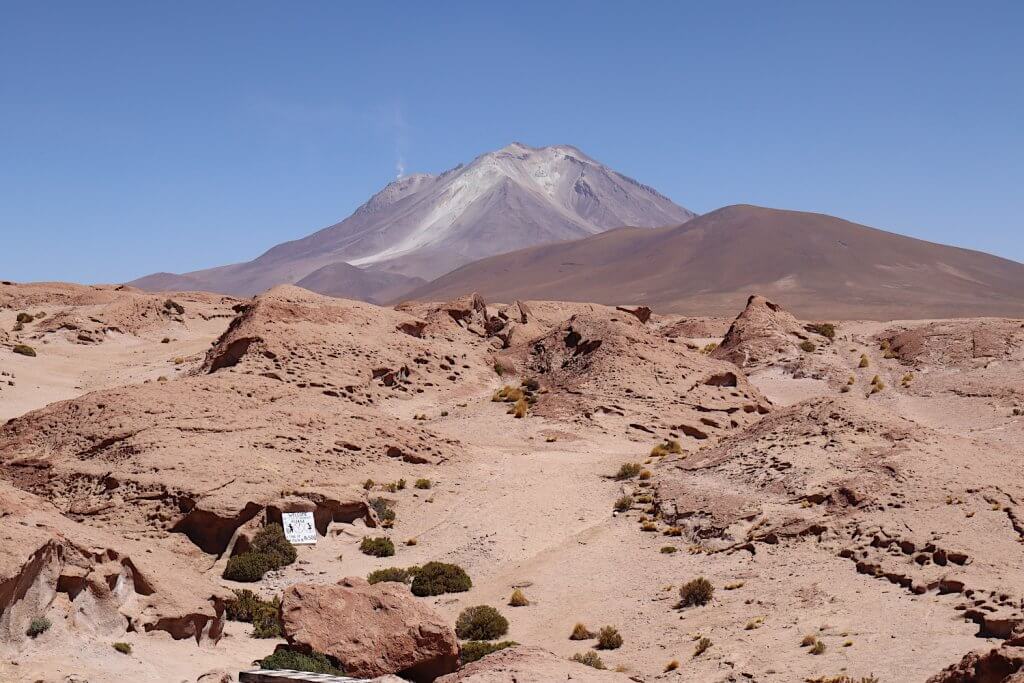
8. Watch Flamingos on Laguna Cañapa
Bolivia is one of the best places in the world to see flamingos in the wilderness in their natural habitat. Laguna Cañapa is one of many small lakes located one hour south-west of the Uyuni salt flats at a height of 4488 meters above sea level. The landscape here is outwordy and simply jaw-dropping. The lake is full of pink flamingos walking peacefully on the shallow waters of the lake. The color palette here is simply unbelievable. Imagine blue colored lake full of pink flamingos reflecting the summits of volcanos, surrounded by yellow grass. It was one of the most striking images I’ve ever had in my life.
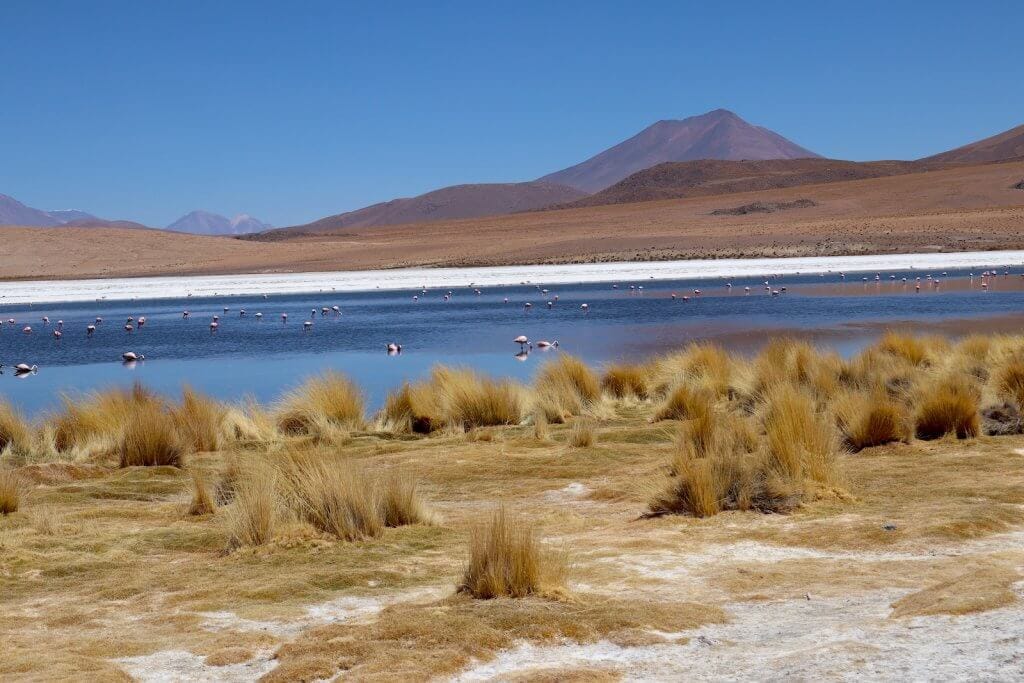
9. Laguna Hedionda or Stinky Lagoon
Laguna Hedionda or the “Stinky Lake” is another great lake to watch the flamingos and enjoy amazing landscapes at an altitude of 4,121 meters (13,520 ft) above sea level. The lake doesn’t really stink so I am not sure where the name is coming from. Here you can see the flamingos much closer and take a few nice photos. There is a small guesthouse directly at the lake. We stopped here for a quick lunch and rested a bit.
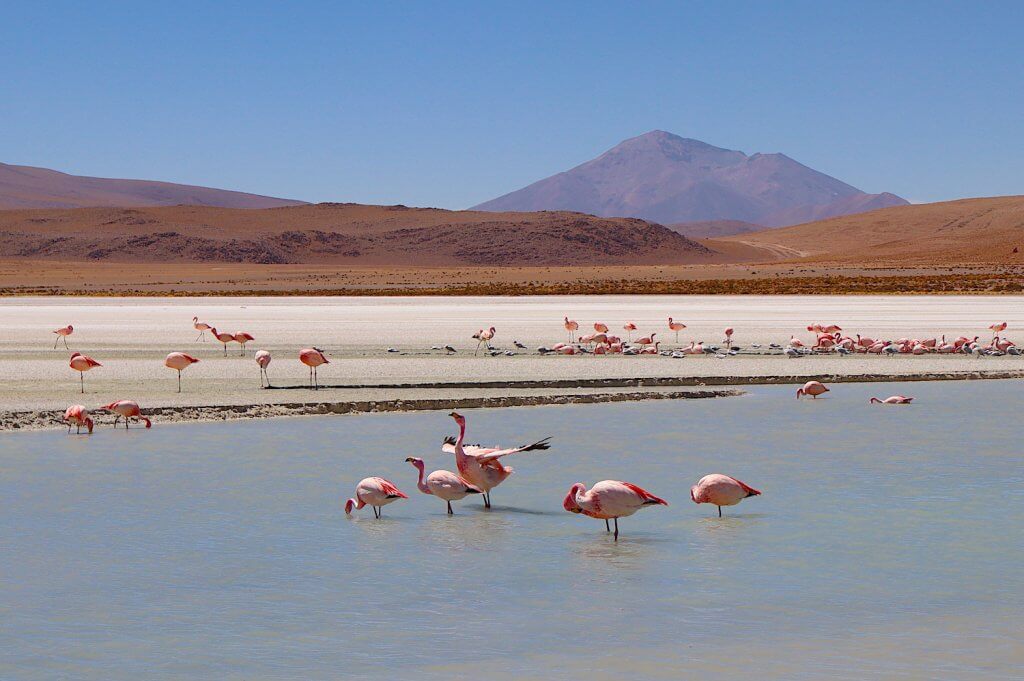
10. Laguna Colorada
Laguna Colorada or the “Red Lagoon” is the most beautiful and famous laguna in Bolivia at an altitude of 4,278 m (14,035 ft) above sea level. It is a shallow salt lake covered by layers of salt and red water due to algae and rich minerals.
I can assure you that in reality is looks even more impressive than on the postcards but its pretty cold and windy here so you need to have warm clothes with you.
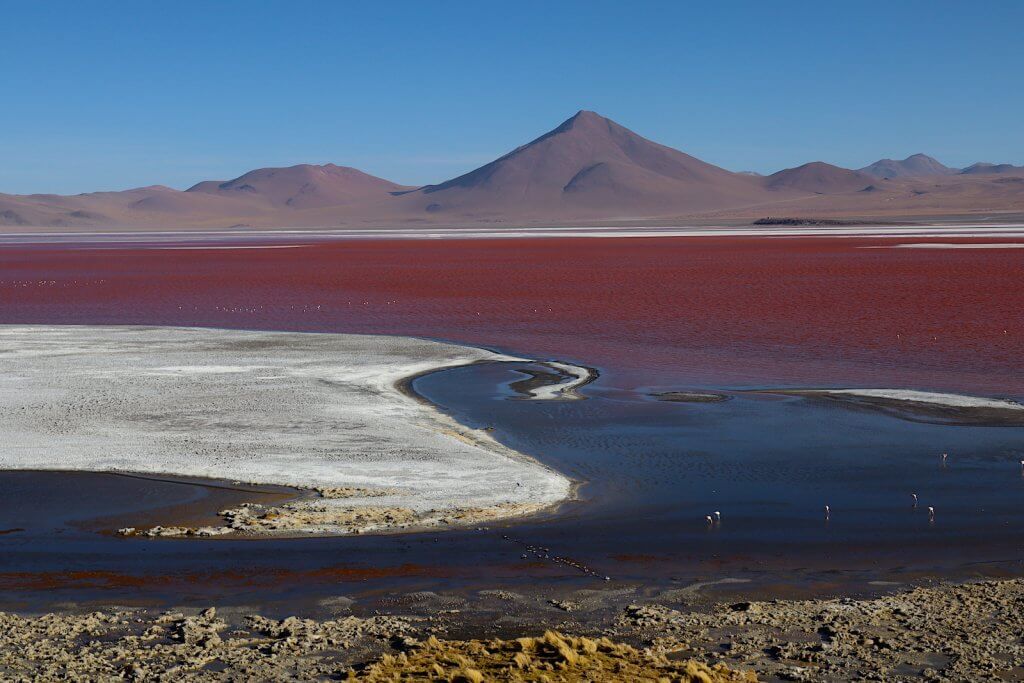
11. Geyser Sol de la Mañana
Sol de Mañana is an area with geothermal activity in the south of Laguna Colorada, very close to the border with Chile and the Atacama desert. It lies at an elevation of 4,900 meters (16,100 ft) above sea level and is one of the highest geothermal fields in the world. Here you will find geysers, hot springs, gas vents (fumaroles) releasing volcanic gases, mud pools, and other geothermal activities. The area with geysers and hot mud pools is not secured, so you can walk very close to them. Its both exciting and scary. At some point, I got carried away while trying to snap the best shot and almost felt into the pools with hot mud bubbles.
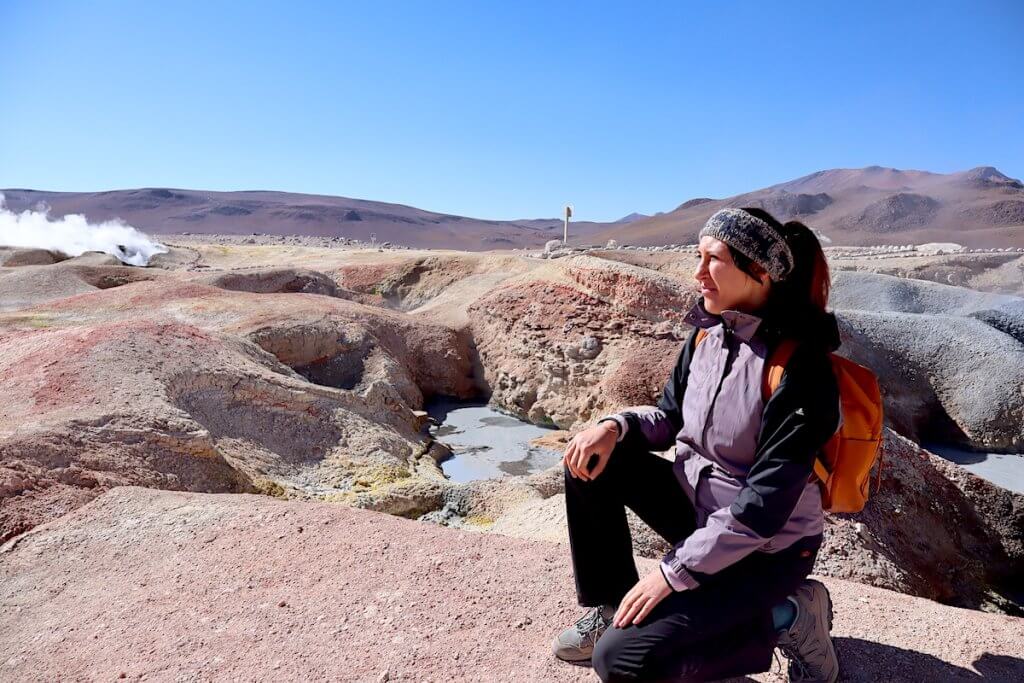
There is no entrance fee on the Bolivian side, but on the Chilean side, you will have to pay 60 USD for the entrance with a guide.
12. Siloli Desert and Arbol de Piedra
Sioli desert is a high-plateu desert in Bolivia. At the elevation of 4500 meters above sea level, it is nicknamed as “Place Where Earth Meets The Sky”. The landscape of the desert resembles Mars surfaces from sci-fi movies and is covered with massive volcanic rock formations of different shapes. The most famous rock formation in the area is the Arbol de Piedra or the Stone Tree. The rock is unique because it resembles a tree. The Siloli desert is considered to be part of the Atacama Desert in neighboring Chile.
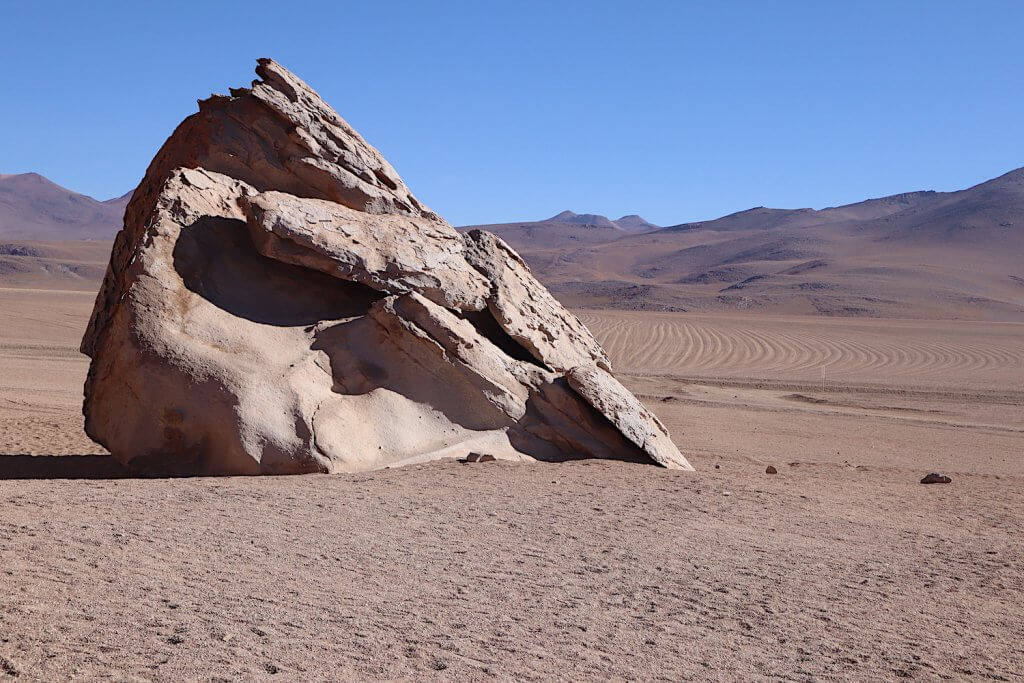
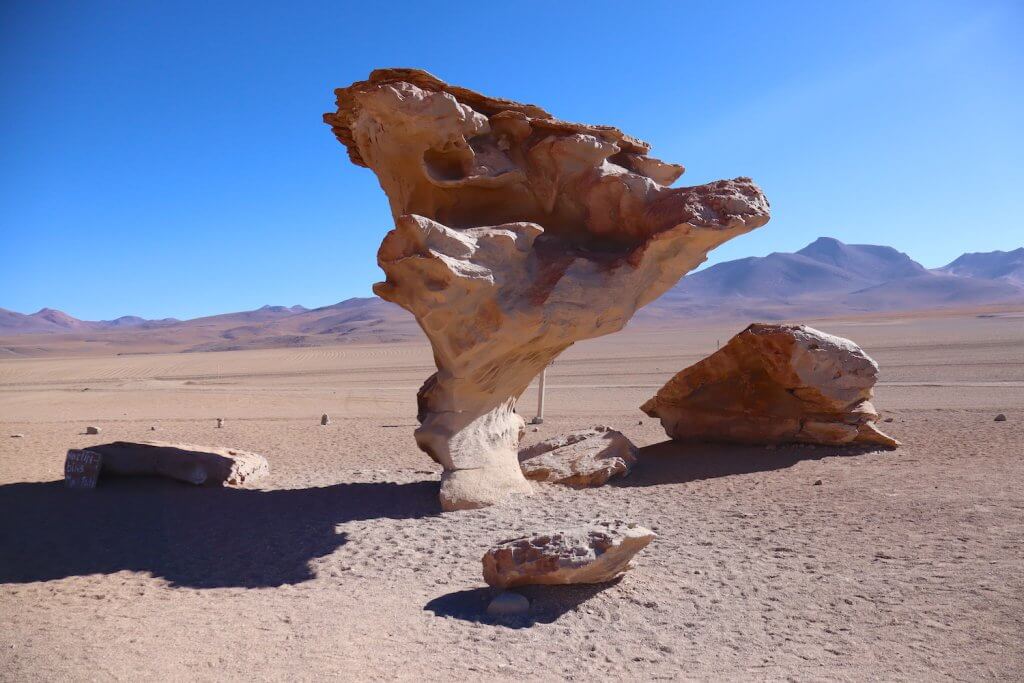
13. Polques Thermal Baths
Aguas Termales de Polques or simply the Thermal Baths of Polques were formed as a result of volcanic activity in this area. The Polques hot springs are full of minerals good for treating some diseases such as arthritis or rheumatism. The water temperature is slightly above 29°C making it comfortable for relaxing. Nevertheless, it is not recommended to stay in the water for too long, especially at an altitude over 4000 meters above sea level. You should aim for a maximum of 30-40 minutes.
The entrance fee is only 6 Bolivianos (around 1 USD). The facility has changing rooms, bathrooms, and a small cafe offering some snacks and drinks. On the Chilean side, you will pay 60 USD for similar thermal baths.
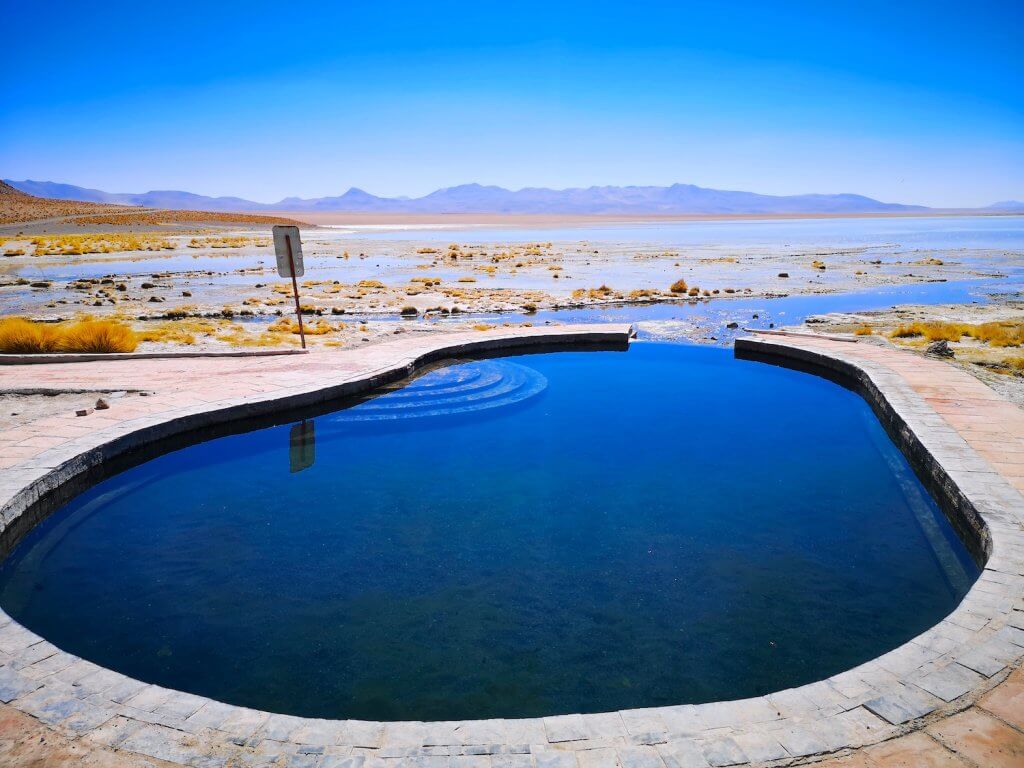
More information can be found here:
Peru Bolivia Chile Itinerary for 4 Weeks
Conclusion
Visiting Uyuni and its surroundings is like stepping into another world. From the mind-blowing Salar de Uyuni, where the salt flats turn into the world’s largest mirror during the rainy season, to the quirky Train Cemetery and the stunning Laguna Colorada, there are many things to do in Uyuni and every moment is an adventure. Sure, it’s a bit challenging with the altitude and remoteness, but the landscapes and experiences make it totally worth it. It’s like Mother Nature decided to show off, and you don’t want to miss the spectacle!
What to Read Next
Best Time to Visit Uyuni Salt Flats
13 Most Beautiful Hikes in South America
My Honest Review of Short Inca Trail to Machu Picchu
How to Find the Best Street Food in Lima, Peru
Disclosure: This article may contain affiliate links. If you purchase something through them, I may earn a small commission at no cost to you. It’s a win-win for both of us and helps to keep this content free.

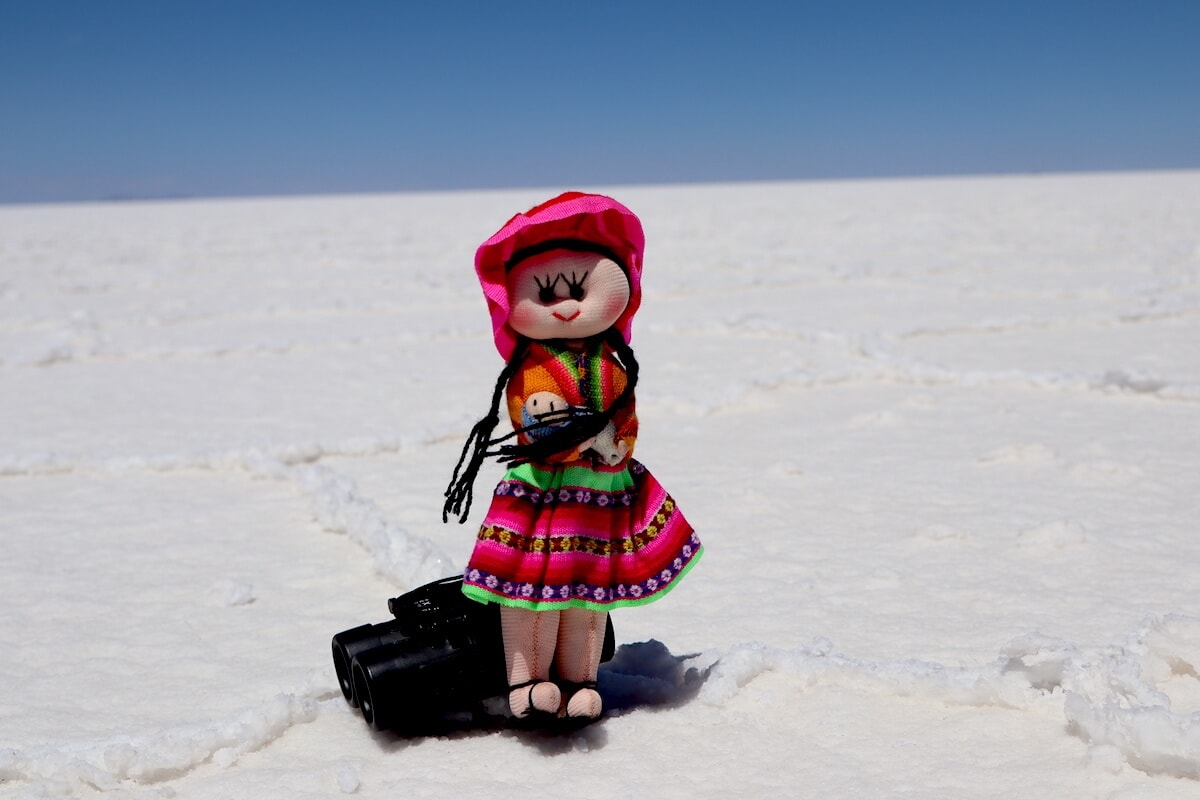
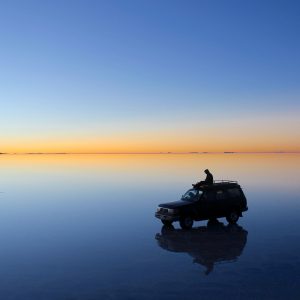
Great post as always 🙂